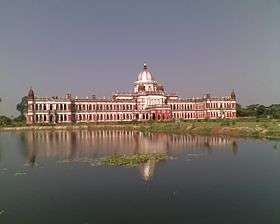Koch dynasty
The Koch dynasty (Pron:kɒʧ), was a dynasty that ruled regions in the eastern part of the Indian subcontinent, mainly the regions of Assam and Bengal; it is named after the Koch community,[1] emerged as the dominant ruling house in the Kamata kingdom in 1515 after the fall of the Khen dynasty in 1498. The first of the Koch kings, Viswa Singha and then his sons, Nara Narayan as the subsequent king and Chilarai as the general, soon occupied the western portion of the erstwhile Kamarupa Kingdom as well as some regions of south Assam. The dynasty forked for the first time into two major branches that controlled Koch Bihar and Koch Hajo. Koch Bihar became a vassal of the Mughals, whereas Koch Hajo came under Ahom control and was subsequently absorbed. Koch Bihar became a princely state during British rule and was absorbed after Indian independence. The third branch of this dynasty at Khaspur disappeared into the Kachari kingdom.
Koch Kingdom Koch Dynasty | |||||||||
|---|---|---|---|---|---|---|---|---|---|
| 1515–1949 | |||||||||
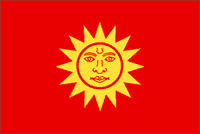 Flag of Cooch Behar | |||||||||
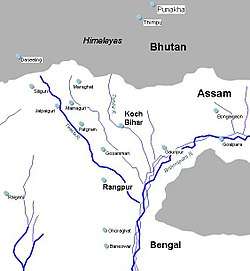 Historical map of Cooch Behar | |||||||||
| Status | Kingdom | ||||||||
| Capital | Chikana Kamatapur | ||||||||
| Common languages | Rajbanshi Assamese Koch Sanskrit (for religious and court usage) | ||||||||
| Religion | Hinduism | ||||||||
| Government | Monarchy | ||||||||
| Maharaja | |||||||||
• 1515–1540 | Viswa Singha | ||||||||
• 1540–1587 | Nara Narayan | ||||||||
• 1922-1947 | Jagaddipendra Narayan | ||||||||
| Historical era | Medieval India | ||||||||
• Established | 1515 | ||||||||
• Disestablished | 1949 | ||||||||
| |||||||||
| Part of a series on the |
| History of Assam |
|---|
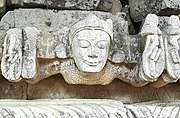 |
|
Proto-historic |
|
Late Medieval |
|
Modern |
|
Contemporary |
| Categories |
|
History
Historical background
After the fall of the Pala dynasty of Kamarupa, the kingdom fractured into different domains in the 12th century. In the east, the Chutiya kingdom emerged on the north and south bank of Brahmaputra River. The Ahom kingdom which emerged in the south bank later occupied and absorbed the larger Chutiya kingdom. To their west was the Kachari kingdom. Sandhya, a ruler of Kamarupanagara (Guwahati) moved his capital further west to present-day North Bengal in the middle of the 13th century and the domain he ruled over came to be called Kamata kingdom.[2] The buffer region, between the eastern kingdoms and Kamata was the domain of the Baro-Bhuyans chieftains. Alauddin Husain Shah of Gaur defeated Nilambar of Kamata in 1498, occupied the region and placed his son, Daniyal in charge. Within a few years, the Baro-Bhuyans, led by one Harup Narayan of the Brahmaputra valley defeated, captured and executed Daniyal, and the region lapsed into Bhuyan confederate rule.[3]
Meanwhile, an alliance was formed when a Mech chief, Haridas Mandal, married two sisters Hira and Jira, the daughters of Hajo, a Koch chief. Haridas Mandal's domain was in Chikna Mountains situated between the Sankosh River and the Champabati River in Kokrajhar district of Undivided Goalpara district of Assam. Bisu, who was to later become Viswa Singha, was born to Haridas Mandal and Hira.[4] Later, Brahman pundits created a legend that lord Siva was the father of Viswa Singha[5] to accord legitimacy to the ruler.
Beginning of the Koch dynasty
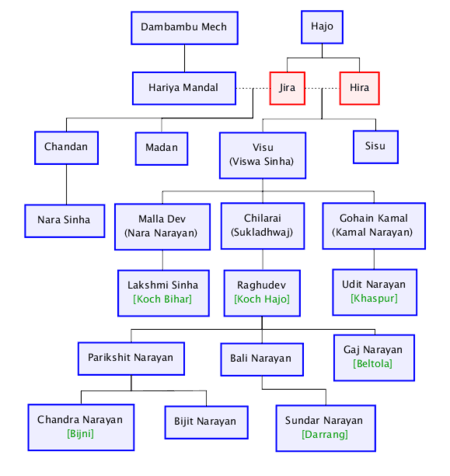
According to J N Sarkar, Viswa Singha belonged to one of the dominant Koch tribes,[7] which were a collection of Mongoloid tribes.[8][9] When Bisu, as Viswa Singha was then known, acquired power, the Brahmins found him out and conferred on him the status of the Kshatriya varna; and the subsequent interaction with Brahmans lead to the Hinduization of his tribesmen.[10] The earliest known ancestor of Viswa Singha was his father Haria Mandal,[11] from the Chiknabari village in Undivided Goalpara district, the head of the twelve most powerful Mech families. Haria Mandal was married to Jira and Hira, daughters of a Koch chief named Hajo, after whom Koch Hajo was named. Viswa Singha was the son of Haria Mandal and Hira.[12]
Consolidation of power
Viswa Singha sought the alliance of tribal (Koch, Garo and Mech) chiefs[13] against the more powerful Baro-Bhuyans and began his campaign around 1509.[14] Successively, he defeated the Bhuyans of Ouguri, Jhargaon, Karnapur, Phulaguri, Bijni and Pandunath (Pandu, in Guwahati).[15] He was particularly stretched by the Bhuyan of Karnapur, and could defeat him only by a stratagem during Bihu. After subjugating the petty rulers, he announced himself the king of Kamata bounded on the east by Barnadi river and on the west by the Karatoya river[16] in the year 1515.[17] He moved his capital from Chikana to Kamatapur (also called Kantapur) which is just a few miles southeast of the present-day Cooch Behar town.[18]
Viswa Singha's two sons, Naranarayan and Shukladhwaj (Chilarai), the king and the commander-in-chief of the army respectively, took the kingdom to its zenith. Nara Narayan made Raghudev, the son of Chilarai, the governor of Koch Hajo, the eastern portion of the country. After the death of Nara Narayan, Raghudev declared independence. The division of the Kamata kingdom into Koch Bihar and Koch Hajo was permanent.
Nara Narayan was impressed by the bhakti saint Srimanta Sankardeva who became a member of his court in the last three years of his life and who established a Satra in the kingdom.
Kings
Rulers of undivided Koch kingdom
- Biswa Singha (1515-1540)
- Nara Narayan (1540-1586)
Rulers of Koch Bihar
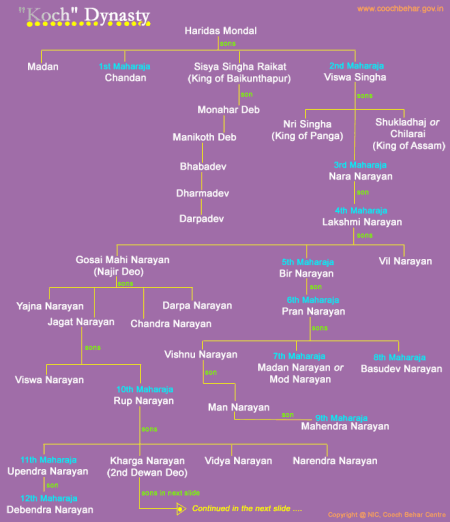
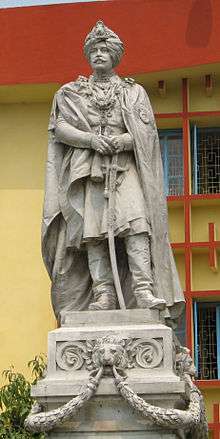
- Lakshmi Narayan
- Bir Narayan
- Pran Narayan
- Basudev Narayan
- Mahindra Narayan
- Roop Narayan
- Upendra Narayan
- Devendra Narayan
- Dhairjendra Narayan
- Rajendra Narayan
- Dharendra Narayan
- Harendra Narayan
- Shivendra Narayan
- Narendra Narayan
- Nripendra Narayan[20]
- Rajendra Narayan II
- Jitendra Narayan (father of Gayatri Devi)
- Jagaddipendra Narayan
- Virajdendra Narayan
Rulers of Koch Hajo
- Raghudev (son of Chilarai, nephew of Nara Narayan)
- Parikshit Narayan
Rulers of Darrang
Parikshit Narayana was attacked by the Mughals stationed at Dhaka in alliance with Lakshmi Narayan of Koch Bihar in 1612. His kingdom Koch Hajo, bounded by Sankosh River in the west and Barnadi river in the east, was occupied by the end of that year. Parikshit Narayan was sent to Delhi for an audience with the Mughal Emperor, but his brother Balinarayan escaped and took refuge in the Ahom kingdom. The region to the east of Barnadi and up to the Bharali river was under the control of some Baro-Bhuyan chieftains, but they were soon removed by the Mughals. In 1615 the Mughals, under Syed Hakim and Syed Aba Bakr, attacked the Ahoms but were repelled back to the Barnadi river. The Ahom king, Prataap Singha, then established Balinarayan as a vassal in the newly acquired region between Barnadi and Bharali rivers, and called it Darrang. Balinarayan's descendants continued to rule the region till it was annexed by the British in 1826.[21]
- Balinarayan (brother of Parikshit Narayan)
- Mahendra Narayan
- Chandra Narayan
- Surya Narayan
Rulers of Beltola
| Outline of South Asian history | ||||||||||||||||||||||||||||||||||||||||||||
|---|---|---|---|---|---|---|---|---|---|---|---|---|---|---|---|---|---|---|---|---|---|---|---|---|---|---|---|---|---|---|---|---|---|---|---|---|---|---|---|---|---|---|---|---|
_without_national_boundaries.svg.png) | ||||||||||||||||||||||||||||||||||||||||||||
|
Palaeolithic (2,500,000–250,000 BC) |
||||||||||||||||||||||||||||||||||||||||||||
|
Neolithic (10,800–3300 BC)
|
||||||||||||||||||||||||||||||||||||||||||||
|
Chalcolithic (3500–1500 BC)
|
||||||||||||||||||||||||||||||||||||||||||||
|
Bronze Age (3300–1300 BC)
|
||||||||||||||||||||||||||||||||||||||||||||
|
Iron Age (1500–200 BC)
|
||||||||||||||||||||||||||||||||||||||||||||
|
Middle Kingdoms (230 BC – AD 1206) |
||||||||||||||||||||||||||||||||||||||||||||
|
Late medieval period (1206–1526)
|
||||||||||||||||||||||||||||||||||||||||||||
|
Early modern period (1526–1858)
|
||||||||||||||||||||||||||||||||||||||||||||
|
Colonial states (1510–1961)
|
||||||||||||||||||||||||||||||||||||||||||||
|
Periods of Sri Lanka
|
||||||||||||||||||||||||||||||||||||||||||||
|
National histories |
||||||||||||||||||||||||||||||||||||||||||||
|
Specialised histories
|
||||||||||||||||||||||||||||||||||||||||||||
- Gaj Narayan Dev (brother of Parikshit Narayan, ruler of Koch Hajo, brother of Balinarayan, first Koch ruler of Darrang).
- Shivendra Narayan Dev (Son of Gaj Narayan)
- Gandharva Narayan Dev (Son of Shivendra Narayan)
- Uttam Narayan Dev (Son of Gandharva Narayan Dev)
- Dhwaja Narayan Dev (Son of Uttam Narayan Dev)
- Jay Narayan Dev (Son of Dhwaja Narayan Dev)
- Lambodar Narayan Dev (Son of Jay Narayan Dev)
- Lokpal Narayan Dev (Son of Lambodar Narayan Dev)
- Amrit Narayan Dev (Son of Lokpal Narayan Dev)
- Chandra Narayan Dev (Son of Lokpal Narayan Dev) (died 1910 CE)
- Rajendra Narayan Dev (Son of Chandra Narayan Dev) (died 1937 CE)
- Lakshmipriya Devi (wife of Rajendra Narayan Dev) (reign:1937-1947 CE died: 1991 CE)
Rulers of Bijni
The Bijni rulers reigned between the Sankosh and the Manas rivers, the region immediately to the east of Koch Bihar.
- Chandra Narayan (son of Parikshit Narayan)
- Joy Narayan
- Shiv Narayan
- Bijoy Narayan
- Mukunda Narayan
- Haridev Narayan
- Indra Narayan
- Amrit Narayan
- Kumud Narayan
- Bhairabendra Narayan
Rulers of Khaspur
The Barak valley was obtained by Chilarai in 1562[22] from the Twipra kingdom during his expedition when he subjugated most of the major rulers in Northeast India and established the Khaspur state with a garrison at Brahmapur, that eventually came to be called Khaspur (Brahmapur→Kochpur→Khaspur). The Koch rule began with the appointment of Kamal Narayan (step-brother of Chilarai and Naranarayan) as the Dewan a couple of years after the establishment of the garrison.[23] Kamalnarayan established eighteen clans of Koch families that took hereditary roles in the state of Khaspur and who came to be known as Dheyans (after Dewan).[24] The independent rule of the Khaspur rulers ended in 1745 when it merged with the kachari kingdom.[22]
The rulers of the Koch kingdom at Khaspur were:[23]
- Kamal Narayan (Gohain Kamal, son of Viswa Singha, governor of Khaspur)
- Udita Narayan (declared independence of Khaspur in 1590)
- Vijay Narayana
- Dhir Narayana
- Mahendra Narayana
- Ranjit
- Nara Singha
- Bhim Singha (his only issue, daughter Kanchani, married a prince of Kachari kingdom, and Khaspur merged with the Kachari kingdom.)
See also
Gallery
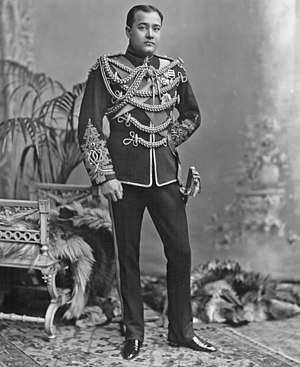 Shri Sir Nripendra Narayan, Maharaja of Cooch Behar.
Shri Sir Nripendra Narayan, Maharaja of Cooch Behar.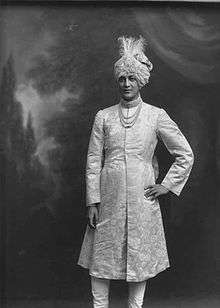 H.H. Maharaja Shri Sir Jitendra Narayan Bhup Bahadur, Maharaja of Cooch-Behar, KCSI, 1913.
H.H. Maharaja Shri Sir Jitendra Narayan Bhup Bahadur, Maharaja of Cooch-Behar, KCSI, 1913.
Notes
- (Nath 1989:2–11)
- (Gogoi 2002, p. 17)
- (Nath 1989:21)
- "...it becomes clear that Biswa Singha's father was a Mech and mother was a Koch and both the tribes were "rude" and "impure", hence non-Aryan or non-Hinduised." (Nath 1989, p. 17)
- (Urban 2009:82)
- (Sarkar 1992:91)
- (Sarkar 1992:69)
- (Sarkar1992:69f). "Minjahuddin found the features of the Koch, Mech, and Tharu tribes similar to a south Siberian tribe. Bryan Hodgson (JASB) xviii (2) 1849, 704-5, classes the Koches with the Bodo and Dhimal tribes. Buchanan agrees. Dalton takes them to be Dravidian. But Risley thinks they represented a fusion of Mongoloid and Dravidian stock, with the later predominating. According to Waddell Mongoloid type of Koches predominated in Assam."
- (Nath 1989:2–3)
- (Gogoi 2002, p. 18)
- (Sarkar 1992:70f)
- (Sarkar 1992:70f). According to some Koch chronicles, a son of Haria Mandal, Chandan, became the king in 1510 followed by Vishwa Singha. According to other chronicles, Chandan was an earlier king. (Nath 1989:17)
- "...Dimarua, Panbari, Beltola, Rani, Moirapur, Borduar, Bholagram, Pantanduar, Chaigaon, Bogaduar, Bongaon, Baku, Luki, Hengerabari. Biswa Singha received the allegiance of these states including those of Darrang, Karaibari, Atiabari, Kamtabari, and Balrampur." (Nath 1989:23–24)
- (Nath 1989:28–29)
- "It is stated that Biswa Singha subjugated the Bar Bhuyan then the Saru Bhuyan and then the Bhuyan of Ouguri. After this he defeated the Daivajnya Chuti Bhuyan and thereafter Kusum Bhuyan, Dihala Bhuyan, Kalia Bhuyan and the Bhuyans of Jhargaon, Kabilash Bhuyan, the Bhuyans of Karnapur, Phulaguri, and Bijni, and finally Pratap Rai Bhuyan of Pandunath, Guwahati. The Gurucaritas also mention Gandhanva Rai, the Bhuyan of Banduka and Sriram Khan of Sajalagram." (Nath 1989:24)
- (Nath 1989:23–24)
- (Nath 1989:28)
- (Nath 1989:35)
- Royal family tree of the "Koch" kings . (n.d.). In Cooch Behar . Retrieved from http://www.coochbehar.gov.in/HTMfiles/royal_history.html Archived 17 May 2018 at the Wayback Machine
- "Princess Daisy of Pless: The Happy Years. An exhibition at Castle Pless". www.rvondeh.dircon.co.uk.
- (Nath 1989:102–104)
- "The Khaspur state originated with Chilarai's invasion in 1562 AD and remained in existence till 1745 when it merged with the Dimasa state of Maibong." (Bhattacharjee 1994:71)
- (Bhattacharjee 1994:71)
- (Bhattacharjee 1994:72)
References
- Urban, Hugh (2009), The Power of Tantra: Religion, Sexuality and the Politics of South Asian Studies, Bloomsbury Publishing, ISBN 9780857715869CS1 maint: ref=harv (link)
- Jacquesson, François (2008). "Discovering Boro-Garo" (PDF). History of an Analytical and Descriptive Linguistic Category.
- Bhattacharjee, J B (1994), "Pre-colonial Political Structure of Barak Valley", in Sangma, Milton S (ed.), Essays on North-east India: Presented in Memory of Professor V. Venkata Rao, New Delhi: Indus Publishing Company, pp. 61–85
- Gogoi, Jahnabi (2002), Agrarian system of medieval Assam, Concept Publishing Company, New Delhi
- Nath, D. (1989), History of the Koch Kingdom, C. 1515-1615, Mittal Publications, pp. 5–6, ISBN 8170991099CS1 maint: ref=harv (link)
- Sarkar, J N (1992), "Chapter IV: Early Rulers of Koch Bihar", in Barpujari, H. K. (ed.), The Comprehensive History of Assam, 2, Guwahati: Assam Publication Board
- Royal History of Koch Bihar, retrieved 5 December 2007
